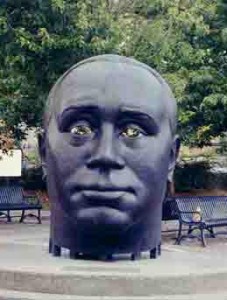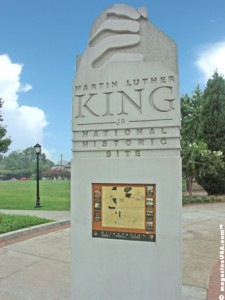When Auburn Avenue is brought up in conversation, the Civil Rights Movement is never far behind. The street gets such an association by right, as influential leaders who came to be the spearhead of the movement were, for the most part, borne on the Avenue. Leaders such as John Dobbs and Martin Luther King are but two prime examples. The Civil Rights Movement can be seen in celebration as it leaves its distinct mark all across the street of its upbringing.
Two impressive structures stand testament to the notion of the impact the Civil Rights Movement had on Sweet Auburn’s built environment. The first being the statue of John Dobbs, located at the John Wesley Dobbs Plaza. John Dobbs was a strong advocate and fighter for the civil liberties as he dedicated his whole life to the advancement of African American standing upon white American society. Dobbs preached the importance of suffrage as the “key to racial advancement” (John Wesley Dobbs) and encouraged thousands of black Americans to register. Due to his insistence on the importance of voting, the African American helped won Hartsfield his seat as Mayor of Atlanta, resulting in two major victories for the community. Through extensive work on Dobbs part, he got Mayor Hartsfield to fulfill the desegregation of the police force (despite being very limited in scope), as well as the installation of street lamps on the Avenue. Through politics, the built environment of Sweet Auburn took on change as new infrastructure found itself amongst the scenery. The statue of John Dobbs head further illustrates the streets commitment and sentiments towards those days of civil rights and demonstrates the role the movement had on the present physicality of the street.
Martin Luther King Jr also places his names on the annals of Sweet Auburn history, as his Historical Center, the King Center has brought national acclaim worldwide, boasting visitors from all over the world. Martin Luther King Jr. has become a common household name, one that has been associated deeply with the civil rights movement. Dr. King, like his predecessor, John Dobbs, fought for civil liberties of all humankind through non-violent means, his involvement help brought the issue onto a national level, and his achievements in the field of civil rights have rocked the modern world. His historic center stands representation of everything King, which in turn means it stood for everything civil rights. Taking into account the prominent position the center holds on the street, its constant care and promotion, there is little left to the imagination on the magnitude of its importance on the built environment.
Established by Mrs. Coretta Scott King in 1968, the King Historic Center still stands to this day as a beacon for the ongoing fight for civil liberties. Put up to change, the center will undergo modifications in its presentation so as to become a more “energetically-engaged educational and social change institution.” (About The King Center) The aspiration to fit into modern societal context further emphasizes the importance of the civil rights movement on Auburn Avenues image.
The center, alongside the statue of John Dobbs, gives credence to the notion that the streets built environment came about due to its heavily enforced history and political affiliations of days past. The statue stands to watch over the street, as the King Center preserves the historic movement through its leader, bearing testament the progress made by African-Americans, and all Americans alike, in the fields of liberty and justice.


